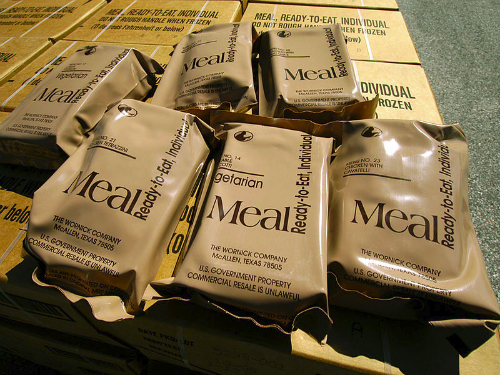Buying survival gear, equipment and supplies present a challenge to virtually everyone as they get started; the tendency is to over-prepare and purchase stuff you will never use – or need.
Here are a few things you should avoid as you make your survival purchases.
Canned Food and MRE’s
I don’t want to completely bash canned food. It certainly has its merits. In most cases it will last a very long time, longer than the expiration date in fact, but most canned foods aren’t very healthy. The whole canning process tends to degrade the nutritional value of the food, and most cans are laced with toxic preservatives and BPA. They’re also heavy and somewhat awkward to store. If you want to can your own food, that’s a worthy endeavor for other reasons, but to go to the store and max out your credit card on canned food is a terrible idea.
After realizing the folly of cans many preppers turn to MRE’s, but they also come with their own set of problems. For me personally, I find them to be utterly disgusting and unhealthy. They usually taste great when you’ve been hiking all day and you’re starving, but in that condition anything can taste good.
Freeze dried food. It’s arguably healthier than most packaged food, and has a shelf life of 10 years or so. It’s small and lightweight, and to me at least, has an excellent flavor. The only downside is that it’s not perfectly edible out of the package. You have to add water (preferably hot), but I consider that a fair trade-off compared to the downsides of the other options. If you live in an area that would have a severe lack of water after the collapse, then maybe canned food is for you. Otherwise, freeze dried is the way to go.
Generator
This is a tough one, because I have to admit that generators can be useful for many short-term disasters. If you need to keep the lights on for a couple of days it’s a viable option, but generators may be completely useless during any long-term disaster. In that case, they become a logistical nightmare. Since it’s safe to assume that there will be gas shortages during any major disaster, do you really want to store enough gasoline to last you six months? And keep in mind that gas has a limited shelf life, and generators are usually really noisy.
Another thing to consider is energy efficiency. The majority of the electricity you use in your home goes toward appliances that provide heat. But the process of turning the combustion from your generator into electricity, and then back into heat, is incredibly inefficient. We don’t normally think about this because the power grid provides electricity at such a low-cost, (relative to a generator) so it’s not a big deal.
If you live in a rural area, you might be able source wood from your environment. Otherwise, You should probably use propane for all your heating needs. There are portable stoves, lanterns, and space heaters that all run on propane. You can buy those tiny Coleman tanks for your stove, or you can buy an adapter to connect it to a larger tank. Most of the lanterns have to take the Coleman tanks, but many of the space heaters are designed for the 20lb tanks as well.
Camouflage
I’d have to say, the most overrated item a prepper could buy is military camouflage. There really isn’t a good reason for it unless you live way out in the sticks, in which case you probably don’t need a military pattern. A good hunting camouflage pattern should be sufficient. And since only 18 percent of the US population lives in a rural area, it’s safe to say that camouflage isn’t really that important for most preppers. If anything, that would just make you stand out in an urban or suburban area.
Even camouflage that is specifically designed for an urban area is a bad idea. Even if it helps to conceal you in a tactical situation, it will still make you stand out in literally every other situation.
Instead of camouflage, just get something that is durable, comfortable, and is dyed in solid, muted earth tones. I’m sure there’s more than one opinion on what that entails, but in this case I’m referring to brown, tan, olive drab, and gray, or at least something similar.
These colors have the advantage of being versatile. You can wear them on city streets or in suburban parks without standing out, but on the off-chance that you wind up in a rural area later on, you won’t be too obvious there either. Basically, it’s not the best you can use for any single environment, but it’s the best you can use in most environments without looking like a stereotypical survivalist.
Your best bet would probably be something made by Dickies. They make great civilian looking clothes that are just as durable as their military counterparts, and it’s not hard to find Dickies shirts and jeans that come in earth tone colors.
A good rule of thumb is that you take a 24 hour “wait period” before purchasing any survival gear or supplies and use that time to assess if you will really use what you want to buy and as importantly, whether you really need it.
By following that rule, you take a major leap in avoiding making impulse purchases that end up wasting money and taking up space that you could otherwise put to good use!
To learn more about what you should avoid buying, check out the SHTF Plan.
Featured Image via Wikipedia
